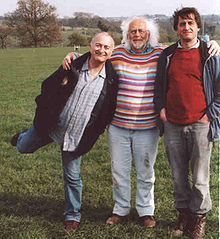Mick Aston

Michael (Mick) Antony Aston (born July 1, 1946 in Oldbury , † June 24, 2013 in Winscombe ) was a British archaeologist . His research focus was in the area of monastic institutions of the early Middle Ages . He was a co-founder of Landscape Archeology .
Life
Mick Aston grew up as the son of a cabinet maker. He studied geography with a minor in archeology at the University of Birmingham . There he met the archaeologist Philip Rahtz , who was enthusiastic about his teaching excavations in summer courses. His first professional employment was at the Oxford City and County Museum , before he became an archaeologist in Somerset County in 1974 - in this role he was a government employee who had to check for planned construction projects whether there were archaeological findings on the building site and whether an excavation or even that under protection must be initiated. In 1978 he became a tutor in local studies at Oxford University . In 1979 he came to the Archaeological Department of Bristol University, where he held the Chair of Landscape Archeology, a sub-discipline of archeology that he co-founded through his early research, from 1996 to 2004.
In 1991 he presented in the four-part series Time Signs of the television station Channel 4 popular science prepares the archaeological work in advance of the establishment of freshwater reservoirs Roadford Lake . The interest in it was so great that the station decided to produce a longer series of short but intensive excavations with Aston and other archaeologists and historians. This format, called Time Team , ran successfully for 20 years and 280 episodes. Aston was also exposed to harsh criticism from specialist colleagues. For him, the show was "a way to share his passion for archeology with ordinary people instead of locking their secrets behind the walls of the universities," as Tony Robinson, the presenter of Time Team puts it.
In his academic work, Aston focused on the landscape archeology of the (early) Middle Ages in the British Isles . He placed particular research focus on the archeology of cities and monasteries.
After his retirement from Bristol University in 2004, he became Honorary Professor at the University of Durham and Honorary Visiting Professor at the University of Exeter . Mick Aston was made a Fellow of the Society of Antiquaries of London in 1976 and of the Royal Geographical Society in 2010.
Publications (selection)
- Landscape Archeology: An Introduction to Fieldwork Techniques on Post-Roman Landscapes . David and Charles, 1974, ISBN 978-0715366707 .
- The Landscape of Towns . Littlehampton Book Services, 1976, ISBN 978-0-460-04194-2 . (Revised version from Sutton Pub Ltd, 2000, ISBN 978-0-7509-2489-4 .)
- Interpreting the Landscape: Landscape Archeology in Local Studies . Routledge, 1985, ISBN 978-0-7134-3650-1 .
- The Medieval Landscape of Wessex . Oxbow, 1994, ISBN 978-0-946897-78-0 .
- Monasteries in the Landscape (revised. Ed.) . The History Press, 2000, ISBN 978-0-7524-1491-1 .
- Atlas archeology: the fascinating world of our ancestors . Paletti, Cologne 2004, ISBN 978-3-89893-265-3 .
- The Shapwick Project, Somerset: A Rural Landscape Explored . Maney, 2007, ISBN 978-1-905981-86-1 .
Web links
- Christopher Dyer : Mick Aston obituary , obituary for The Guardian , June 25, 2013, accessed August 16, 2017
- Literature by and about Mick Aston in the WorldCat bibliographic database
- Mick Aston at the Internet Movie Database (English)
Individual evidence
- ↑ a b c Marcus Williamson: Mick Aston: Archaeologist who found television fame on 'Time Team'. In: The Independent . June 25, 2013, accessed August 16, 2017 .
- ^ A b Professor Mick Aston, 1946-2013. University of Bristol: Department of Archeology and Anthropology, June 25, 2013, accessed August 16, 2017 .
- ↑ Timothy Darvill: Pathways to a Panoramic Past. A Brief History of Landscape Archeology in Europe . In: Bruno David, Julian Thomas (Eds.): Handbook of Landscape Archeology . Routledge, 2016, ISBN 978-1-315-42772-0 , pp. 60 (English, limited preview in Google Book Search).
- ↑ Professor Mick Aston. In: The Daily Telegraph . June 25, 2013, accessed August 16, 2017 .
| personal data | |
|---|---|
| SURNAME | Aston, Mick |
| ALTERNATIVE NAMES | Aston, Michael Antony (full name) |
| BRIEF DESCRIPTION | British archaeologist |
| DATE OF BIRTH | July 1, 1946 |
| PLACE OF BIRTH | Oldbury |
| DATE OF DEATH | June 24, 2013 |
| Place of death | Winscombe (Somerset) , Somerset , United Kingdom |